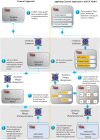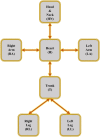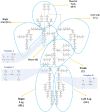Hierarchical semantic composition of biosimulation models using bond graphs
- PMID: 33983945
- PMCID: PMC8148364
- DOI: 10.1371/journal.pcbi.1008859
Hierarchical semantic composition of biosimulation models using bond graphs
Abstract
Simulating complex biological and physiological systems and predicting their behaviours under different conditions remains challenging. Breaking systems into smaller and more manageable modules can address this challenge, assisting both model development and simulation. Nevertheless, existing computational models in biology and physiology are often not modular and therefore difficult to assemble into larger models. Even when this is possible, the resulting model may not be useful due to inconsistencies either with the laws of physics or the physiological behaviour of the system. Here, we propose a general methodology for composing models, combining the energy-based bond graph approach with semantics-based annotations. This approach improves model composition and ensures that a composite model is physically plausible. As an example, we demonstrate this approach to automated model composition using a model of human arterial circulation. The major benefit is that modellers can spend more time on understanding the behaviour of complex biological and physiological systems and less time wrangling with model composition.
Conflict of interest statement
The authors have declared that no competing interests exist.
Figures












Similar articles
-
A semantics, energy-based approach to automate biomodel composition.PLoS One. 2022 Jun 3;17(6):e0269497. doi: 10.1371/journal.pone.0269497. eCollection 2022. PLoS One. 2022. PMID: 35657966 Free PMC article.
-
Multiple ontologies in action: composite annotations for biosimulation models.J Biomed Inform. 2011 Feb;44(1):146-54. doi: 10.1016/j.jbi.2010.06.007. Epub 2010 Jun 30. J Biomed Inform. 2011. PMID: 20601121 Free PMC article.
-
Integration of multi-scale biosimulation models via light-weight semantics.Pac Symp Biocomput. 2008:414-25. Pac Symp Biocomput. 2008. PMID: 18229704 Free PMC article.
-
Graph theoretic modeling of large-scale semantic networks.J Biomed Inform. 2006 Aug;39(4):451-64. doi: 10.1016/j.jbi.2005.10.007. Epub 2005 Dec 15. J Biomed Inform. 2006. PMID: 16442849 Review.
-
Graphs in molecular biology.BMC Bioinformatics. 2007 Sep 27;8 Suppl 6(Suppl 6):S8. doi: 10.1186/1471-2105-8-S6-S8. BMC Bioinformatics. 2007. PMID: 17903289 Free PMC article. Review.
Cited by
-
Oxidative Stress: The Role of Antioxidant Phytochemicals in the Prevention and Treatment of Diseases.Int J Mol Sci. 2024 Mar 13;25(6):3264. doi: 10.3390/ijms25063264. Int J Mol Sci. 2024. PMID: 38542238 Free PMC article. Review.
-
Computational fluid dynamic modeling of the lymphatic system: a review of existing models and future directions.Biomech Model Mechanobiol. 2024 Feb;23(1):3-22. doi: 10.1007/s10237-023-01780-9. Epub 2023 Oct 30. Biomech Model Mechanobiol. 2024. PMID: 37902894 Free PMC article. Review.
-
Modular assembly of dynamic models in systems biology.PLoS Comput Biol. 2021 Oct 13;17(10):e1009513. doi: 10.1371/journal.pcbi.1009513. eCollection 2021 Oct. PLoS Comput Biol. 2021. PMID: 34644304 Free PMC article.
-
A semantics, energy-based approach to automate biomodel composition.PLoS One. 2022 Jun 3;17(6):e0269497. doi: 10.1371/journal.pone.0269497. eCollection 2022. PLoS One. 2022. PMID: 35657966 Free PMC article.
-
Building a search tool for compositely annotated entities using Transformer-based approach: Case study in Biosimulation Model Search Engine (BMSE).F1000Res. 2023 Feb 10;12:162. doi: 10.12688/f1000research.128982.1. eCollection 2023. F1000Res. 2023. PMID: 37842339 Free PMC article.
References
Publication types
MeSH terms
Grants and funding
LinkOut - more resources
Full Text Sources
Other Literature Sources
Research Materials

